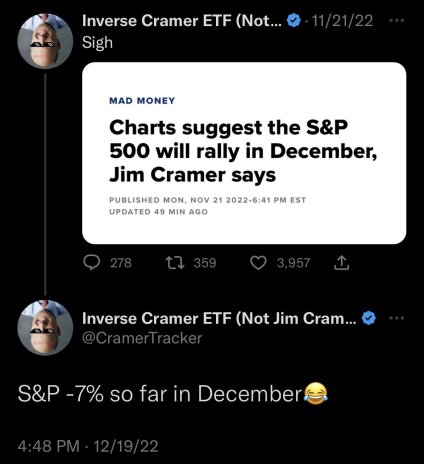On October 5, Tuttle Capital filed a preliminary prospectus for two potential ETFs, the Inverse Cramer ETF (SJIM) and the Long Cramer ETF (LJIM) which are intended to short Jim Cramer’s public stock picks and go long those same picks, respectively.
While the novelty of turning the inverse of a very public investor’s picks into an ETF may make it seem like it’s a big joke, this is actually not the fund company’s first rodeo. In 2021 they successfully launched the AXS Short Innovation Daily ETF (SARK), which is designed to be inverse the positions of Cathie Wood’s ARK Innovation ETF (ARKK).
And the fund is largely delivering as promised, with a one-year return of 56.6% vs. a loss of 69.2% by ARKK.
Before we dive into whether it’s worth investing in an inverse Cramer fund, I’d like to share a post by @CramerTracker, which is a popular follow among the denizens of r/WallStreetBets and other online-centric groups of investors.
[text_ad]
That, in a nutshell, is the central premise of the “Inverse Cramer.” Whatever pick Jim Cramer makes, the market will do the opposite. As much as it can be “fun” for the “extremely online” meme stock crowd to share Cramer’s bad calls, there’s not much evidence to support a fund that’s totally dedicated to shorting him.
This online index, which uses Cramer’s public picks, has an alleged 32% return in the last year; however, it hasn’t been updated or re-indexed since June, which raises questions about the accuracy and the methodology.
There have been several more robust studies looking at the picks of the Mad Money host, like this 15-year study, and a 2009 graduate paper cited by the Financial Times finding that while “Cramer may be entertaining and mesmerizing to many of his viewers, his aggregate or average stock recommendations are neither extraordinarily good nor unusually bad.” The 15-year study had similar findings, namely that Jim Cramer performs better on positive buy recommendations, but otherwise did not consistently generate better-than-expected returns.
So, if Cramer is neither consistently better nor worse than other analysts out there, why the attention to his picks?
Personally, I’ll chalk it up to the hyperbole. There are very few celebrity financial analysts, and it took a special combination of enthusiasm and investing familiarity to move Cramer from “financial celebrity” to “celebrity.” I’m sure we’ve all got a handful of friends or family members that aren’t particularly interested in finance and investing but would recognize Jim Cramer if he popped up on TV.
So, even acknowledging that Cramer is more showman than savant, what about investors that are more interested in a long Cramer fund than the inverse Cramer, a fan of the show, for instance?
That’s where SARK and the preliminary prospectus come in. As we saw above, SARK underperformed its benchmark by about 12%. We can chalk some of that up to the fund’s active management style (more transactions mean more transaction fees, going inverse a position has higher costs when using derivatives, etc.) but the lion’s share is likely attributable to the fund manager’s discretion; Tuttle Capital’s CEO Matthew Tuttle attributes the tracking error to the fund’s “glide path,” which arises from the timing of allocation into and out of positions, also a perfectly reasonable explanation for the discrepancy.
And that’s something any prospective investor will have to worry about with either the inverse Cramer or long Cramer portfolio. This language is from the prospectus filing, emphasis mine (Tuttle Capital, in response to this article, has clarified that uncertainty in the following language is at the advice of counsel as opposed to a window into management’s investing style):
The Fund’s adviser monitors Cramer’s stock selection and market recommendations throughout the trading day as publicly announced on Twitter or his television programs broadcast on CNBC, and follows those recommendations to produce a direct correlation to those recommendation. The Fund goes long on stocks or ETFs that represent sectors that Cramer is positive on. The Fund uses Index ETFs and inverse Index ETFs to take the same side of Cramer’s announced market view. The Fund sells securities when Cramer recommends selling the security or if, at the adviser’s discretion if Cramer takes no position on the security for over a week. The Fund’s portfolio is comprised generally of 20 to 25 equity equally-weighted securities of any market capitalization of domestic and foreign issuers.
The adviser further has discretion to not transact in equity securities mentioned by Cramer or engage in related transactions if such securities or transactions are (i) not well suited for ETFs, (ii) have an excessive level of risk, (iii) illiquid, or (iv) negatively impacting the Fund’s ability to meet IRS and Investment Company Act of 1940 diversification requirements. In addition, the adviser has discretion to determine whether Cramer’s statement about a given equity securities is in fact an investment recommendation and thus eligible for inclusion in the Fund’s portfolio.
Every fund manager maintains some discretion over the trades the fund makes, how much cash it holds, etc. But an inverse Cramer fund that uses the manager’s discretion to determine whether a recommendation from Jim Cramer is actually a recommendation should raise red flags for passive investors.
If you’re a big fan of Jim Cramer, and you like some of his picks, you’ll be better served following him on Twitter or watching his show and making buy or sell decisions based on your own research.
To learn more about Cabot’s favorite stocks this month, click here to download your free report.
[author_ad]
*This article was originally published in 2022 and has been updated to incorporate the response received from Tuttle Capital Management.


